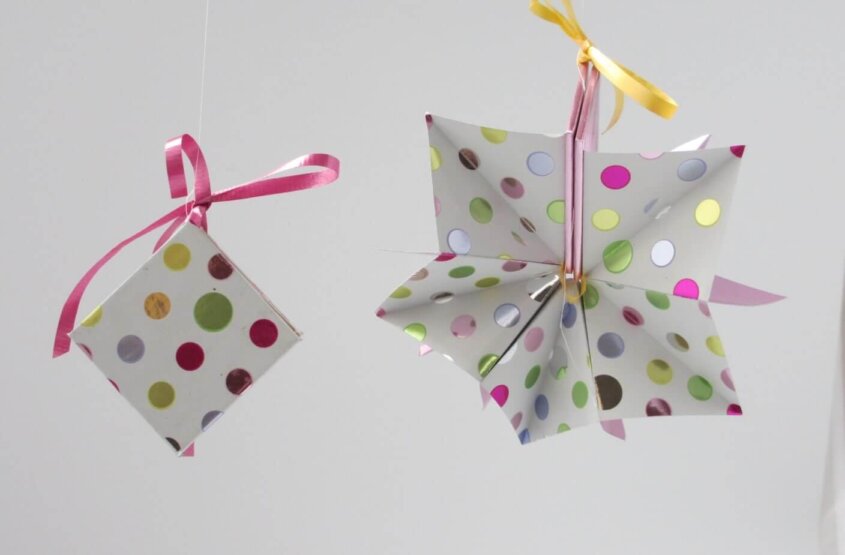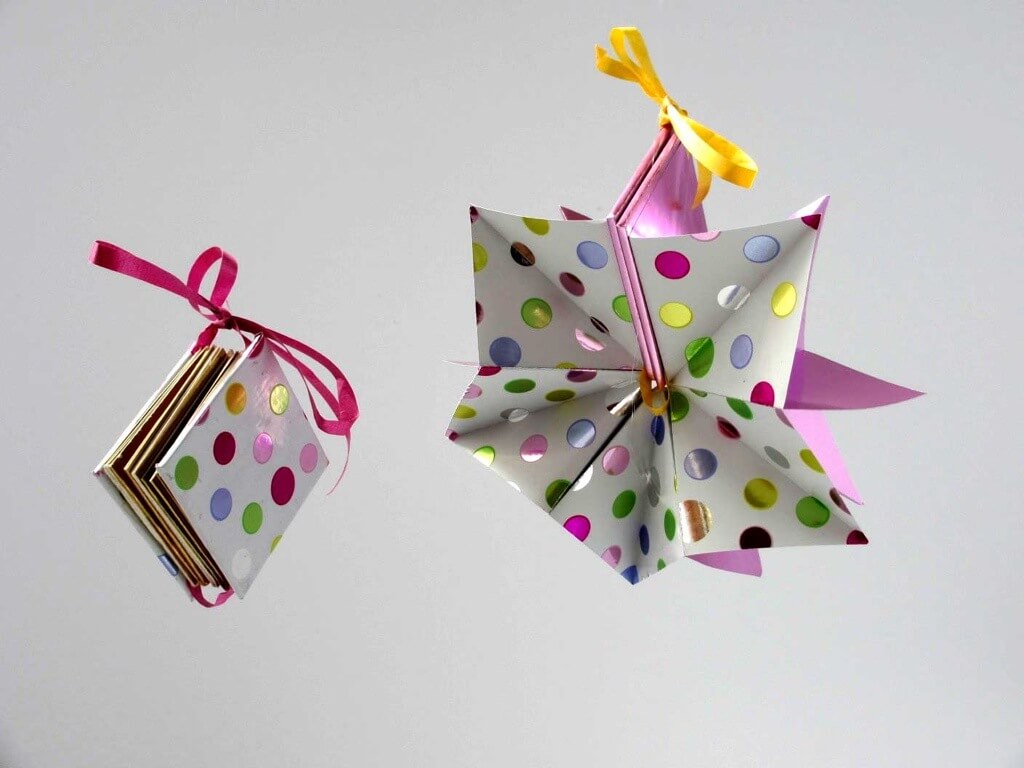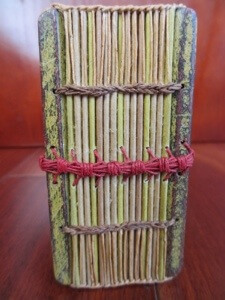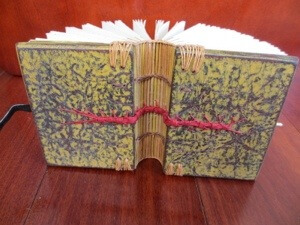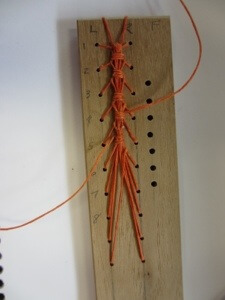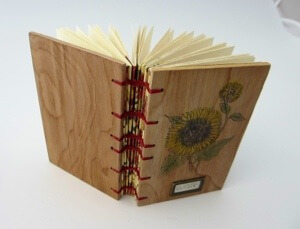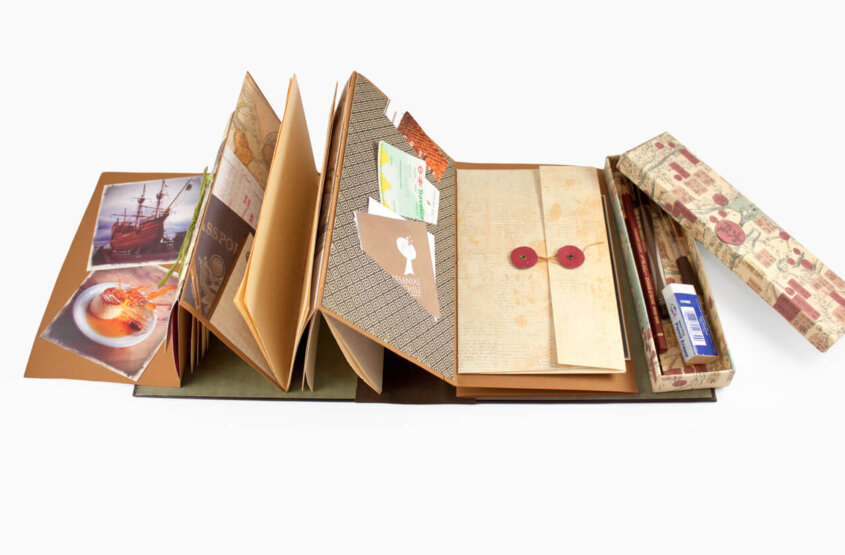I thought I was too late to submit my proposal for the Osher Lifelong Learning Institute (OLLI) but managed to write one and come up with some cute little books. I cannot teach the workshop until early December so it made sense to come up with something easy, seasonal, and fun. This is the result—a miniature (2″x2″) popup book. I used double sided wrapping paper for the pages and covers. This little thing doubles as a holiday ornament! I plan on making several variations, including a book for a necklace. It was a great escape from a dreary day!
So many structures so little time.
My two children live in San Diego and I’m always looking for an excuse to go down to visit. I have loved Daniel Essig’s books for years and the idea that I could actually see and handle his books was reason enough to book a flight. Even better, he was offering a three day workshop to make a sewn book with wooden covers. I’ve done little sewing so I knew this was going to be a bit of a challenge. It was. However, I loved working with wood and all of the tools: drill press, power tools, hand drills, and my personal favorite, the industrial lathe tool we used to create metal posts. I enjoyed sewing the caterpillar but the stitches along the edges drove me batty (and I’m sure Daniel too). But. Now I know I can actually sew these stitches and maybe even begin to understand Keith Smith’s instructions on the same.
The covers were created using wood covered with handmade crumpled flax paper made by Bookmakers Inc.. Covers were painted with layers of milk paint, sanded to reveal the layers, and then waxed with shoe polish to add luster.
One of my favorite students in the class was the high school woodshop teacher who volunteered his beautiful and well equipped classroom for our workshop. He had no bookmaking experience and created a wonderful book with patience and good humor.
I had a three day workshop coming up with Daniel Essig so I thought it might be a good idea to assemble another book using the coptic stitch—hoping my fingers would remember what to do. I used scrap wood from my recycled wood stash (from my husband and his woodworking friends) and thought I would sew the book with one type of stitch, then cut those out and try another type of stitch. As usually happens, I got way more involved with the project than intended and ended up with a nice little book. The sunflower is a heat transfer with color smudged into the wood. The little metal frame is glued on with scientific jargon underneath. I am sending the book to a dear friend and her name and mine is burned into the inside back cover. I can always find more wood….
One of the best ways to get back into one’s artwork is to commit to something! I was asked to teach an OLLI (Osher Life Long Learning Institute) book arts course this summer and I agreed. I thought it might be a good idea if I made the structure first ! and since the students might well be beginners, I wanted something that involved introductory techniques. I thought a travel journal would be a good idea and after looking at a number of structures I decided to adapt a travel journal from Re-bound, Creating Handmade Books from Recycled and Repurposed Materials, by Jeannine Stein. I replaced the more difficult structures and rewrote the instructions for a beginning student.
The journal is surprisingly easy to make and students should enjoy customizing it. Since the accordion fold structure is only attached at the inside back of the cover, the pages open out to the left and right, enabling the students to attach a number of folios or envelopes in the valley folds. The entire book was put together using double-sided tape, gluesticks, and linen thread. Much as I love PVA glue, it does require more instruction and can be very messy. Various elementary techniques will be taught (in fact, this may be more important than the end result): the art of folding, the 3 & 5 hole pamphlet stitch, cutting and measuring, proper gluing, determining paper type and grain, and creating a cover using bookcloth for the spine.
After creating all of the text block and finding myself drawn to vintage images and colors, I decided that the gameboard I have chosen for the front and back covers just didn’t do what I wanted. However, the backs of the boards were a dark, textured black and I used that for the outside of the back and covered the other board for the front. Gameboards are nice because they are easier to find than book board (at least in Humboldt County, California) and if it is cut to size, two of the edges would be finished and two would require covering. Re-bound uses cigar box paper to cover the edges but I haven’t seen that in Humboldt County; however, on one of my frequent thrift shop adventures, I found some stretchy black tape with adhesive on one side and it worked like a charm. Turns out it was electrical tape and I just bought 5 rolls (white, red, blue, orange, green) at my local hardware store! The box is a bracelet jewelry box and I covered it with paper I printed myself with an image of a vintage Chinese map. The photographs were taken on a recent trip to Patagonia, the box carries pencils, pens, and erasers, the slit pockets and envelopes hold ephemera. Folio papers are handmade mango paper from Solutions in Arcata.
OLLI course: Introduction to the Book Arts, Create a Custom Journal. Tuesdays June 12, 19, 26, 1:00 pm to 3:00 pm.
OLLI website summer catalog will be up later this month.

